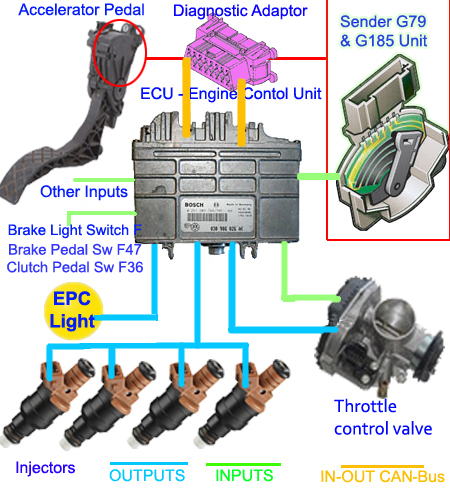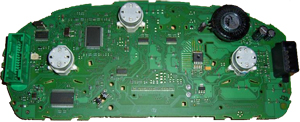NO PROBLEM FOUND
Have you ever taken your under warranty car to your service agent after experiencing extreme EPC Light and Engine Light activity, only to be told "No problem found"? Does the inside of your under 75,000km car sound like an aviary when you turn-on it's fan? Or, do you constantly have to top-up your oil level between oil changes or at least every 1500 km? How do you handle it, when you go to the agents, to complain about excessive oil consumption, only to be told that, “all cars use oil and oil consumption is a normal part of a car’s operation, beside oil consumption issues were disclosed in the vehicle owner’s manual". Has your car behaved like a washing machine during a rinse and spin cycle while driving on the freeway, misfiring, shaking and scaring the living day light out of you? If yes to any of the above, then you must be driving a VAG Car - VW, Skoda, Audi or Seat. Yes, when those injector coils go faulty in mid travel, it really frightens you because the car feels like is going to fall apart any moment.
This also happens to VW, Jetta, VW Caddy, Volkswagen Jetta, Volkswagen Golf, Volkswagen Beetle, Volkswagen Passat, Volkswagen Touareg, Porsche Cayenne, Volkswagen Amarok, Volkswagen Caddy, Volkswagen CC, Volkswagen Fox, Volkswagen Gol G5, Volkswagen Golf Mk6, Volkswagen Jetta, Volkswagen Scirocco, Volkswagen Sharan, Volkswagen Tiguan, Volkswagen Touareg, Volkswagen Touran, Audi A3, Audi A6, Audi A7, Audi A8, Audi Q5, Audi Q7, Volkswagen Phaeton, Volkswagen Polo, Volkswagen Lupo and Volkswagen Passat.
I've experienced the radiator fan blades disintegrate while driving, and the unbalanced rotation caused the same, exact, identical, engine shake. Then I've also experienced starting difficulties, irregular idling, poor fuel economy, hesitant acceleration, engine misfires and engine stalls. Not to mention the the constant, "in your face" red engine warning light. All of which turned out to be components of the charge air path, especially the Mass Airflow Sensor (MAF).
When the "No problem Found" response became unbearable, it was time for self discovery. So what I've come to realize is that a mass air flow sensor, is integral part of every modern VAG engine and is normally situated somewhere inside the intake air duct, between the air filter and the engine.
I've owned several cars, amongst which were Renault, Opel, Mercedes Benz and Mazda yet never ever had the need to replace a MAF even after several years. However with VW, it needs to be cleaned or replaced regularly every 2-3 years. Cleaning a MAF is cheaper than replacing it though replacing a MAF sensor is just easier. It is DIY job because the MAF replacement cost at a VW dealers averages about R1500,00.
VAG engines require a "perfect blend" of air and fuel for absolute combustion. This "perfect blend" is known as stoichiometric or Lambda = 1, which essentially means "the mixture is right" in mechanical jargon. The vacumn caused by the turbo blower and the pistons down-ward travel creates air charge. The main aim of the charge air path is to provide a smooth increase in torque, and to deliver high efficiency throughout its operating ranges. This air charge is measured by the MAF, so by implication a properly functioning MAF is absolutely crucial to a smooth ride. But in modern Engine Management Systems their are several components that contribute to maintaining this "perfect blend" among which are:-
1) The Electronic throttle control (EPC)
2) Charge air pressure sensor G31
3) Mass Air Flow (MAF) sensor G70
4) Barometric Pressure (BARO) sensor F96
5) Intake Air Temperature (IAT) sensor G42 / G299
So any fault in the Mass Air Flow (MAF) sensor G70 will trigger the EPC light, because the Motronic engine control unit (ECU) uses it as an engine load signal and as a reference data to calculate the signal plausibility of other sensor inputs, when and how much fuel to deliver, and when to generate a spark for the relieve cylinder. At the same time, it will also trigger a DTC in memory. The MAF also works in conjunction with an O2 sensor that provides a “closed-loop” feedback known as short term fuel trim (STFT) / Long term fuel trim (LTFT), in order to make corrections to that predicted air mass. If the air filter isn't replaced on a regular basis, a build- up of impurities in the MAF will cause it to start failing when it gets too dirty to do its job and trigger the EPC light.
Have you ever taken your under warranty car to your service agent after experiencing extreme EPC Light and Engine Light activity, only to be told "No problem found"? Does the inside of your under 75,000km car sound like an aviary when you turn-on it's fan? Or, do you constantly have to top-up your oil level between oil changes or at least every 1500 km? How do you handle it, when you go to the agents, to complain about excessive oil consumption, only to be told that, “all cars use oil and oil consumption is a normal part of a car’s operation, beside oil consumption issues were disclosed in the vehicle owner’s manual". Has your car behaved like a washing machine during a rinse and spin cycle while driving on the freeway, misfiring, shaking and scaring the living day light out of you? If yes to any of the above, then you must be driving a VAG Car - VW, Skoda, Audi or Seat. Yes, when those injector coils go faulty in mid travel, it really frightens you because the car feels like is going to fall apart any moment.
This also happens to VW, Jetta, VW Caddy, Volkswagen Jetta, Volkswagen Golf, Volkswagen Beetle, Volkswagen Passat, Volkswagen Touareg, Porsche Cayenne, Volkswagen Amarok, Volkswagen Caddy, Volkswagen CC, Volkswagen Fox, Volkswagen Gol G5, Volkswagen Golf Mk6, Volkswagen Jetta, Volkswagen Scirocco, Volkswagen Sharan, Volkswagen Tiguan, Volkswagen Touareg, Volkswagen Touran, Audi A3, Audi A6, Audi A7, Audi A8, Audi Q5, Audi Q7, Volkswagen Phaeton, Volkswagen Polo, Volkswagen Lupo and Volkswagen Passat.
I've experienced the radiator fan blades disintegrate while driving, and the unbalanced rotation caused the same, exact, identical, engine shake. Then I've also experienced starting difficulties, irregular idling, poor fuel economy, hesitant acceleration, engine misfires and engine stalls. Not to mention the the constant, "in your face" red engine warning light. All of which turned out to be components of the charge air path, especially the Mass Airflow Sensor (MAF).
When the "No problem Found" response became unbearable, it was time for self discovery. So what I've come to realize is that a mass air flow sensor, is integral part of every modern VAG engine and is normally situated somewhere inside the intake air duct, between the air filter and the engine.
I've owned several cars, amongst which were Renault, Opel, Mercedes Benz and Mazda yet never ever had the need to replace a MAF even after several years. However with VW, it needs to be cleaned or replaced regularly every 2-3 years. Cleaning a MAF is cheaper than replacing it though replacing a MAF sensor is just easier. It is DIY job because the MAF replacement cost at a VW dealers averages about R1500,00.
MASS AIRFLOW SENSOR
VAG engines require a "perfect blend" of air and fuel for absolute combustion. This "perfect blend" is known as stoichiometric or Lambda = 1, which essentially means "the mixture is right" in mechanical jargon. The vacumn caused by the turbo blower and the pistons down-ward travel creates air charge. The main aim of the charge air path is to provide a smooth increase in torque, and to deliver high efficiency throughout its operating ranges. This air charge is measured by the MAF, so by implication a properly functioning MAF is absolutely crucial to a smooth ride. But in modern Engine Management Systems their are several components that contribute to maintaining this "perfect blend" among which are:-
1) The Electronic throttle control (EPC)
2) Charge air pressure sensor G31
3) Mass Air Flow (MAF) sensor G70
4) Barometric Pressure (BARO) sensor F96
5) Intake Air Temperature (IAT) sensor G42 / G299
So any fault in the Mass Air Flow (MAF) sensor G70 will trigger the EPC light, because the Motronic engine control unit (ECU) uses it as an engine load signal and as a reference data to calculate the signal plausibility of other sensor inputs, when and how much fuel to deliver, and when to generate a spark for the relieve cylinder. At the same time, it will also trigger a DTC in memory. The MAF also works in conjunction with an O2 sensor that provides a “closed-loop” feedback known as short term fuel trim (STFT) / Long term fuel trim (LTFT), in order to make corrections to that predicted air mass. If the air filter isn't replaced on a regular basis, a build- up of impurities in the MAF will cause it to start failing when it gets too dirty to do its job and trigger the EPC light.


